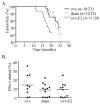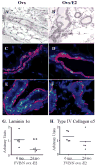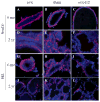Ovarian hormones are not required for PRL-induced mammary tumorigenesis, but estrogen enhances neoplastic processes
- PMID: 19635758
- PMCID: PMC2841967
- DOI: 10.1677/JOE-09-0221
Ovarian hormones are not required for PRL-induced mammary tumorigenesis, but estrogen enhances neoplastic processes
Abstract
Epidemiologic studies have demonstrated that increased prolactin (PRL) exposure raises the risk of invasive estrogen receptor alpha (ERalpha)-positive breast cancer in women. However, the mechanism(s) whereby this occurs and the interactions with estrogen itself in this disease remain poorly understood. In order to investigate the role of ovarian hormones in the disease process, we employed a transgenic model neu-related lipocalin (NRL)-PRL in which transgenic PRL is directed to mammary epithelial cells by the PRL- and estrogen-insensitive NRL promoter, mimicking the endogenous PRL expression within the breast observed in women. This high local exposure leads to mammary lesion development and eventually carcinomas. Ovariectomy (ovx), shortly after puberty, did not alter the incidence or latency of PRL-induced mammary carcinomas, consistent with the independence of PRL from circulating estrogens as a risk factor for invasive breast cancer in women. However, chronic estrogen administration to ovx NRL-PRL females decreased the latency of both ERalpha-positive and -negative tumors. We identified multiple mechanisms that may underlie this observation. Elevated estrogen exposure cooperated with PRL to increase epithelial proliferation and myoepithelial abnormalities, increasing the incidence of preneoplastic lesions. Critical components of the extracellular matrix secreted by the myoepithelium were reduced with age, and transgenic PRL raised transcripts for tenascin-C and maspin, both associated with tumor progression and poor prognosis in subclasses of clinical breast tumors. Mammary pERK1/2 and pAkt, but not phosphorylated Stat5, were markedly elevated by local PRL. Together, these findings indicate that PRL employs multiple mechanisms to promote mammary tumorigenesis.
Conflict of interest statement
Figures






Similar articles
-
Prolactin-induced mouse mammary carcinomas model estrogen resistant luminal breast cancer.Breast Cancer Res. 2011 Jan 28;13(1):R11. doi: 10.1186/bcr2819. Breast Cancer Res. 2011. PMID: 21276249 Free PMC article.
-
Prolactin drives estrogen receptor-alpha-dependent ductal expansion and synergizes with transforming growth factor-alpha to induce mammary tumors in males.Am J Pathol. 2008 Jan;172(1):194-202. doi: 10.2353/ajpath.2008.070597. Epub 2007 Dec 21. Am J Pathol. 2008. PMID: 18156207 Free PMC article.
-
Prolactin promotes mammary pathogenesis independently from cyclin D1.Am J Pathol. 2012 Jul;181(1):294-302. doi: 10.1016/j.ajpath.2012.03.041. Epub 2012 May 29. Am J Pathol. 2012. PMID: 22658484 Free PMC article.
-
Prolactin receptor gene transcriptional control, regulatory modalities relevant to breast cancer resistance and invasiveness.Front Endocrinol (Lausanne). 2022 Sep 15;13:949396. doi: 10.3389/fendo.2022.949396. eCollection 2022. Front Endocrinol (Lausanne). 2022. PMID: 36187116 Free PMC article. Review.
-
Estrogen metabolites and breast cancer.Steroids. 2015 Jul;99(Pt A):61-6. doi: 10.1016/j.steroids.2014.08.003. Epub 2014 Aug 26. Steroids. 2015. PMID: 25168343 Review.
Cited by
-
Form and function: how estrogen and progesterone regulate the mammary epithelial hierarchy.J Mammary Gland Biol Neoplasia. 2015 Jun;20(1-2):9-25. doi: 10.1007/s10911-015-9337-0. Epub 2015 Jul 19. J Mammary Gland Biol Neoplasia. 2015. PMID: 26188694 Free PMC article. Review.
-
Stiff collagen matrices increase tumorigenic prolactin signaling in breast cancer cells.J Biol Chem. 2013 May 3;288(18):12722-32. doi: 10.1074/jbc.M112.447631. Epub 2013 Mar 24. J Biol Chem. 2013. PMID: 23530035 Free PMC article.
-
Prolactin cooperates with loss of p53 to promote claudin-low mammary carcinomas.Oncogene. 2014 Jun 5;33(23):3075-82. doi: 10.1038/onc.2013.278. Epub 2013 Jul 22. Oncogene. 2014. PMID: 23873024 Free PMC article.
-
A humanized pattern of aromatase expression is associated with mammary hyperplasia in mice.Endocrinology. 2012 Jun;153(6):2701-13. doi: 10.1210/en.2011-1761. Epub 2012 Apr 16. Endocrinology. 2012. PMID: 22508516 Free PMC article.
-
Breast Cancer and Prolactin - New Mechanisms and Models.Endocrinology. 2022 Oct 1;163(10):bqac122. doi: 10.1210/endocr/bqac122. Endocrinology. 2022. PMID: 35922139 Free PMC article. Review.
References
-
- Alarid ET. Lives and times of nuclear receptors. Molecular Endocrinology. 2006;20:1972–1981. - PubMed
-
- Anderson E, Clarke RB, Howell A. Estrogen receptor in mammary gland physiology. In: Ethier SP, editor. Contemporary Endocrinology: Endocrine Oncology. Totowa, NJ: Humana Press Inc; 2000. pp. 1–16.
Publication types
MeSH terms
Substances
Grants and funding
LinkOut - more resources
Full Text Sources
Medical
Research Materials
Miscellaneous

